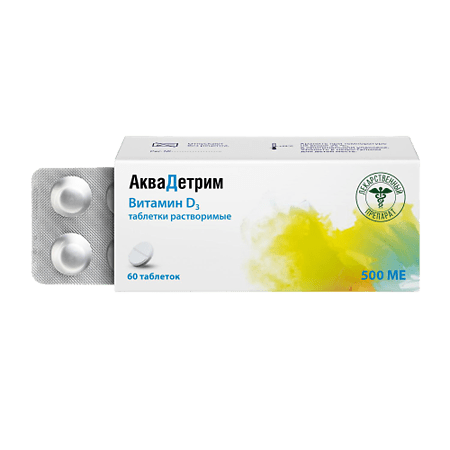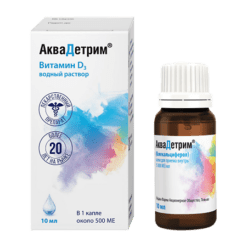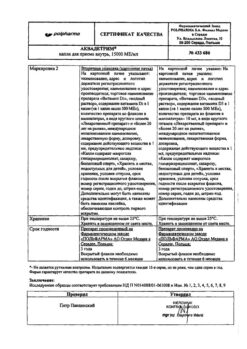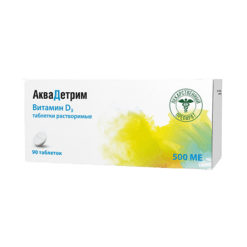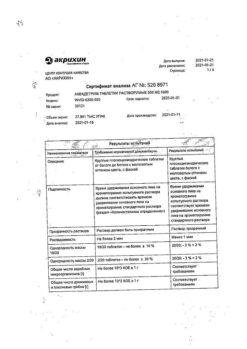No products in the cart.
Aquadetrim, 500 me 60 pcs.
€12.00 €10.00
Description
Aqueous vitamin D3 solution is absorbed better than the oil solution. Premature infants have insufficient formation and inflow of bile into the intestine, which impairs absorption of vitamins in the form of oil solutions.
After oral administration, colecalciferol is absorbed in the small intestine. It is metabolized in the liver and kidneys. Half-life period of colocalciferol from blood is several days and may be prolonged in case of renal insufficiency. The drug passes through the placental barrier and into the mother’s milk.
It is excreted by the kidneys in small amounts, most of it is excreted with the bile. Vitamin D3 has a property of cumulation.
Indications
Indications
– Prevention and treatment of vitamin D deficiency.
– Prevention and treatment of rickets.
– In the complex treatment of osteoporosis, including postmenopausal.
Active ingredient
Active ingredient
Composition
Composition
Tablets – 1 tablet:
How to take, the dosage
How to take, the dosage
Ingestion.
The tablet is dissolved in water at room temperature (the amount of water is at least 15 ml – 1 tablespoon). The tablet takes some time to dissolve (about 1-2 minutes). Unless otherwise prescribed by the doctor, the drug is used in the following dosages:
Preventive doses:
Preterm infants from 4 weeks of life to 2-3 years of age with proper care and adequate exposure to fresh air: 500 ME (1 tablet) per day.
Premature infants from 4 weeks of life, twins, infants in poor living conditions: 1000-1500 ME (2-3 tablets) per day.
In the summertime, the dose may be limited to 500 ME (1 tablet) per day.
– In healthy adults without absorption disorders: 500 ME (1 tablet) per day, in adult patients with malabsorption syndrome: 3000-5000 ME (6-10 tablets) per day (except in patients with glucose-galactose malabsorption).
Pregnant women: a daily dose of 500 ME (1 tablet) of vitamin D3 for the duration of pregnancy, or taking 1000 ME (2 tablets) per day starting at 28 weeks of pregnancy.
In the postmenopausal period, 500-1000 ME (1-2 tablets) daily.
Therapeutic doses:
In rickets: 1000-5000 ME (2-10 tablets) daily, depending on the severity of rickets (I, II, or III) and the course variant, for 4-6 weeks, under close monitoring of the clinical condition and examination of biochemical parameters (calcium, phosphorus, alkaline phosphatase) of blood and urine. You should start with 1000 ME for 3-5 days. Then, if tolerated well, the dose is increased to an individual therapeutic dose (usually 3000 ME). A dose of 5000 ME is prescribed only if there are marked bone changes.
If necessary, after a one-week break, treatment may be repeated. Treatment is continued until a clear therapeutic effect is obtained, with a transition to a prophylactic dose of 500-1500 ME per day thereafter.
In the complex treatment of postmenopausal osteoporosis: 500-1000 ME (1-2 tablets) per day. To maintain adequate blood levels of vitamin D concentration (> 30 ng/ml 25(OH)D): 2000 ME (4 tablets) per day. The dosage is usually prescribed according to the amount of vitamin D taken with food.
Interaction
Interaction
Antiepileptic agents, rifampicin, colestyramine decrease reabsorption of vitamin D3.
The use simultaneously with thiazide diuretics increases the risk of hypercalcemia.
The concomitant therapy with cardiac glycosides (foxglove) may increase their toxic potential due to hypercalcemia. In such patients, ECG values and plasma and urinary calcium levels should be monitored, and doses of cardiac glycosides should be adjusted. Also, plasma levels of digoxin and digitoxin should be monitored if indicated.
The concomitant therapy with glucocorticosteroids may decrease the effectiveness of vitamin D3.
Special Instructions
Special Instructions
Avoid overdose.
Individual provision of a specific need should consider all possible sources of this vitamin. Overdoses of vitamin D3 administered at prolonged or shock doses can cause chronic hypervitaminosis D3.
The determination of a child’s daily vitamin D requirement and the route of administration must be established by the physician individually and adjusted each time during periodic examinations, especially in the first months of life.
When adequate blood levels of vitamin D (> 30 ng/ml 25(OH)D) in adults can be continued with maintenance therapy with Aquadetrim at a dose of 1500-2000 ME (3-4 tablets) daily.
In the absence of water the tablet can be dissolved in the mouth.
Do not use high doses of calcium at the same time as vitamin D3.
Periodic monitoring of phosphate concentrations in blood and urine is necessary during treatment.
Long-term use of colocalciferol requires regular monitoring of serum and urine calcium levels, and renal function must be assessed by measuring serum creatinine levels. If necessary, the dose of colocalciferol should be adjusted depending on the level of calcium in the blood serum.
Features
Features
Vitamin D3 is a natural form of vitamin D that is formed in the human skin under the influence of sunlight. Compared to vitamin D2, it has 25% higher activity.
Vitamin D binds to a specific vitamin D receptor (VDR) that regulates the expression of many genes, including the TRPV6 ion channel genes (provides calcium absorption in the gut), CALB1 (calbindin; provides calcium transport into the bloodstream), BGLAP (osteocalcin; provides bone mineralization and calcium homeostasis), SPP1 (osteopontin; regulates osteoclast migration), REN (renin; provides blood pressure regulation as a key element of renin-angiotensin-aldosterone regulatory system), IGFBP (insulin-like growth factor binding protein; enhances the action of insulin-like growth factor), FGF23 and FGFR23 (fibroblast growth factor 23; regulates calcium levels, phosphate anion, fibroblast cell division processes), TGFB1 (transforming growth factor beta-1; regulates cell division and differentiation processes of osteocytes, chondrocytes, fibroblasts and keratinocytes), LRP2 (LDL-receptor-related protein 2; mediates endocytosis of low-density lipoproteins), INSR (insulin receptor; provides insulin effects on all cell types).
Vitamin D3 is an active anti-rachitis factor. The most important function of vitamin D3 is to regulate calcium and phosphate metabolism, which promotes proper mineralization and skeletal growth.
Calciferol plays an essential role in the absorption of calcium and phosphate in the intestine, in the transport of mineral salts and in the calcification of bones, and also regulates the excretion of calcium and phosphate by the kidneys.
The concentration of calcium ions in blood determines the muscle tone of skeletal muscles, myocardial function, contributes to nerve stimulation and regulates the process of blood clotting.
Deficiency of vitamin D in food, disorders of its absorption, calcium deficiency, as well as lack of exposure to the sun during rapid growth of children leads to rickets, osteomalacia in adults, pregnant women may show symptoms of tetany, disruption of bone calcification in newborns.
The increased need for vitamin D occurs in women during menopause, as they often develop osteoporosis due to hormonal disorders. Vitamin D has a number of so called extracellular effects.
Vitamin D is involved in the functioning of the immune system by modulating cytokine levels and regulates the division of T-helper lymphocytes and the differentiation of B-lymphocytes. A number of studies have shown a decrease in the incidence of respiratory tract infections with vitamin D supplementation.
It is shown that vitamin D is an important link in homeostasis of the immune system: it prevents autoimmune diseases (diabetes mellitus type 1, multiple sclerosis, rheumatoid arthritis, inflammatory bowel diseases, etc.).
Vitamin D has antiproliferative and pro-differentiation effects, which determine the oncoprotective effect of vitamin D. It is noted that the incidence of some tumors (breast cancer, colon cancer) is increased with low levels of vitamin D in the blood.
Vitamin D is involved in the regulation of carbohydrate and fat metabolism through its influence on the synthesis of IRS1 (insulin receptor substrate 1; participates in intracellular insulin receptor signaling pathways), IGF (insulin-like growth factor; regulates fat and muscle tissue balance), PPAR-5 (peroxisome proliferator activated receptor type 5; helps process excess cholesterol).
According to epidemiological studies, vitamin D deficiency is associated with the risk of metabolic disorders (metabolic syndrome and type 2 diabetes). Vitamin D receptors and metabolizing enzymes are expressed in arterial vessels, the heart and virtually all cells and tissues relevant to the pathogenesis of cardiovascular disease. Antiatherosclerotic effects, renin suppression and prevention of myocardial damage, etc. have been shown in animal models.
Low levels of vitamin D in humans are associated with adverse cardiovascular risk factors such as diabetes, dyslipidemia, arterial hypertension, and are associated with the risk of cardiovascular accidents, including strokes. In studies on experimental models of Alzheimer’s disease, vitamin D3 has been shown to reduce amyloid accumulation in the brain and improve cognitive function. In non-interventional studies in humans, the incidence of dementia and Alzheimer’s disease has been shown to increase with low vitamin D levels and low dietary intake of vitamin D. There has been a worsening of cognitive function and the incidence of Alzheimer’s disease at low levels of vitamin D.
Contraindications
Contraindications
Hypersensitivity to the components of the drug. Hypervitaminosis D, increased concentration of calcium in blood (hypercalcemia), increased excretion of calcium in the urine (hypercalciuria), urolithiasis (formation of calcium oxalate stones), sarcoidosis, acute and chronic liver and kidney disease, renal failure, active pulmonary tuberculosis, pseudohypoparathyreosis, sucrose/isomaltase deficiency, fructose intolerance, glucose-galactose malabsorption.
With caution:immobilization state, atherosclerosis, during pregnancy and breastfeeding.
In patients taking thiazide diuretics and, in patients with cardiovascular disease taking cardiac glycosides.
In infants with a predisposition to early congestion of the fontanelle (when the anterior vertex is small from birth).
Side effects
Side effects
Hypersensitivity to the components of the drug, hypervitaminosis D (symptoms of hypervitaminosis: loss of appetite, nausea, vomiting; headaches, muscle and joint pains; constipation; dry mouth; polyuria; weakness; mental disorders, including depression; weight loss; sleep disturbances; fever; protein, leukocytes, hyaline cylinders appear in the urine; blood calcium levels increase and excretion with the urine; renal, blood vessel and lung calcinosis are possible).
In case of signs of hypervitaminosis D, the drug should be discontinued, calcium intake should be limited, and vitamins A, C, and B should be prescribed.
Overdose
Overdose
Symptoms of overdose: decreased appetite, nausea, vomiting, constipation, restlessness, thirst, polyuria, diarrhea, colic. Headache, muscle and joint pain, mental disorders including depression, stupor, ataxia and progressive weight loss are common symptoms. Renal dysfunction develops with albuminuria, erythrocyturia and polyuria, increased potassium loss, hypostenuria, nycturia and increased blood pressure.
In severe cases corneal clouding may occur, and less frequently – edema of the optic nerve papilla, iris inflammation up to cataract development. Kidney stones may form, calcification of soft tissues, including blood vessels, heart, lungs and skin may occur. Rarely, cholestatic jaundice develops.
Treatment
Stop use of the drug. Talk to your doctor. Drink plenty of fluids. Hospitalization may be necessary.
Similarities
Similarities
Additional information
| Weight | 0.018 kg |
|---|---|
| Manufacturer | Akrihin HFC JSC, Russia |
| Medication form | instant tablets |
| Brand | Akrihin HFC JSC |
Other forms…
Related products
Buy Aquadetrim, 500 me 60 pcs. with delivery to USA, UK, Europe and over 120 other countries.

